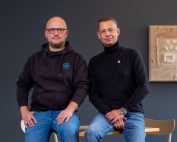With this interview, BalticWind.EU is starting a debate on how the green reindustrialization in Europe implementation under the “Net-Zero Industry Act” should take place. In a series of interviews, podcasts and webinars, we will show the importance of developing various technologies that are key to the wind industry.
We spoke with Valery Godinez-Azcuaga, Director at the Sensoria™ Center of Excellence about inspection and monitoring technologies. He emphasized the significance of technological advances in driving the acceleration of wind farm development. The wind industry has witnessed remarkable growth since the establishment of the first megawatt-size turbines during the third industrial revolution. However, the focus has now shifted to offshore wind generation, demanding further innovation in a variety of key technologies. Transferring solutions such as monitoring systems for wind turbine drive trains, non-destructive evaluation (NDE) techniques for rotor blade inspections, or remotely operated vehicles (ROVs) for offshore turbines’ below water components from other industries has proven effective in expediting wind energy development. With the advent of the fourth industrial revolution, characterized by digital-physical integration, the wind industry, also known as Wind 4.0, aims to enhance turbine reliability and energy production through advanced technological solutions.
Paweł Wróbel, Managing Director, BalticWind.EU:
The development of renewable energy is driven by advances in many technologies. How much of the acceleration of wind farms development depends on technological advances?
Valery Godinez-Azcuaga, Director, Sensoria™ Center of Excellence, Vice President of Engineering & Product Development, MISTRAS Group: If we put the development of Wind Energy in the context of the historic industrial revolutions, we can say that the modern basis of the wind industry was put in place during the second industrial revolution when Charles F. Brush developed the first automatic wind turbine to produce electricity in 1887 and Poul la Cour developed the first modern wind generator with a small number of rotor blades in 1899.
However, it was only in the third industrial revolution (circa 1960) that the first megawatt-size wind turbines and commercially operated wind farms were established in the U.S. and Denmark. Since then, we have seen tremendous growth in the wind industry, primarily onshore. Bigger and better machines demanded better operation & maintenance, which in turn required better tools for inspection and monitoring of the different components of the wind turbines, such as towers, drivetrains, and blades.
These needs have been partially satisfied by using inspection and monitoring systems previously tested and validated in other industries, such as oil & gas and traditional power utilities. But the focus now, at least in Europe, has moved towards offshore wind generation, and turbines with longer blades and taller towers, requiring further innovation to inspection and monitoring technologies.
Modern blade management programs that include targeted remote inspections, maintenance with autonomous robots, and continuous monitoring will help wind farm owners and operators, both onshore and off, to deliver more energy, more efficiently. All this is happening in the context of the fourth industrial revolution, in which new developments in the digital domain, and connectivity with the physical world through sensors, allow us to harness the potential of digital-physical integration.
In summary, the acceleration of wind farm development, especially offshore, will heavily depend on the technological advances of the fourth industrial revolution. This stage in the wind industry’s growth is sometimes referred to as Wind 4.0, with the objective to increase wind turbine reliability and energy production.
What is currently the biggest challenge? Where are the main bottlenecks in terms of technology?
The movement towards Wind 4.0 is succeeding in generating large volumes of data along the life cycle of wind turbines. For example:
- Data can be collected before the turbine becomes operational
- Regular inspections can deliver gigabytes of data in the form of high-resolution images of defects
- Blade condition monitoring systems (CMS) like Sensoria™ can collect enormous amounts of data in the form of signals from different types of sensors
- Data from Supervisory Control and Data Acquisition (SCADA) systems and weather stations can provide temperature, pressure, wind speed, and relative humidity.
This means that we are, in fact, data rich, but if these data are not processed intelligently, we could be “information poor.” To me, one of the most essential technological bottlenecks is how to turn data into actionable information that can be used to improve the performance of wind turbines without affecting the machine’s structural health.
What are your views about the transfer of solutions from other industries to renewable energy sources?
As I mentioned above, many solutions have been translated from industries like oil & gas and traditional power utilities to the renewable space, such as monitoring systems for wind turbine drive trains, non-destructive evaluation (NDE) techniques for rotor blade inspections, or remotely operated vehicles (ROVs) for offshore turbines’ below water components. Another example is the technology developed for the construction of offshore oil rigs that is now used to deploy substantial offshore wind turbines, and the techniques developed in the deployment of floating offshore platforms that are being adapted to build floating wind turbines. This is a natural phenomenon in technological evolution that avoids “reinventing the wheel” and accelerates the development of the wind industries.
Are wind-industry related skills/competencies needed in other industries to trigger the adaptation of good solutions for the wind industry?
We have seen a lot of migration of technical people with oil & gas expertise to the wind industry lately. This phenomenon has a positive effect as long as it is clear that critical aspects of the wind industry are not encountered anywhere else. Educating these highly-skilled people in those idiosyncrasies is important so that they can develop sound solutions for the wind industry.













